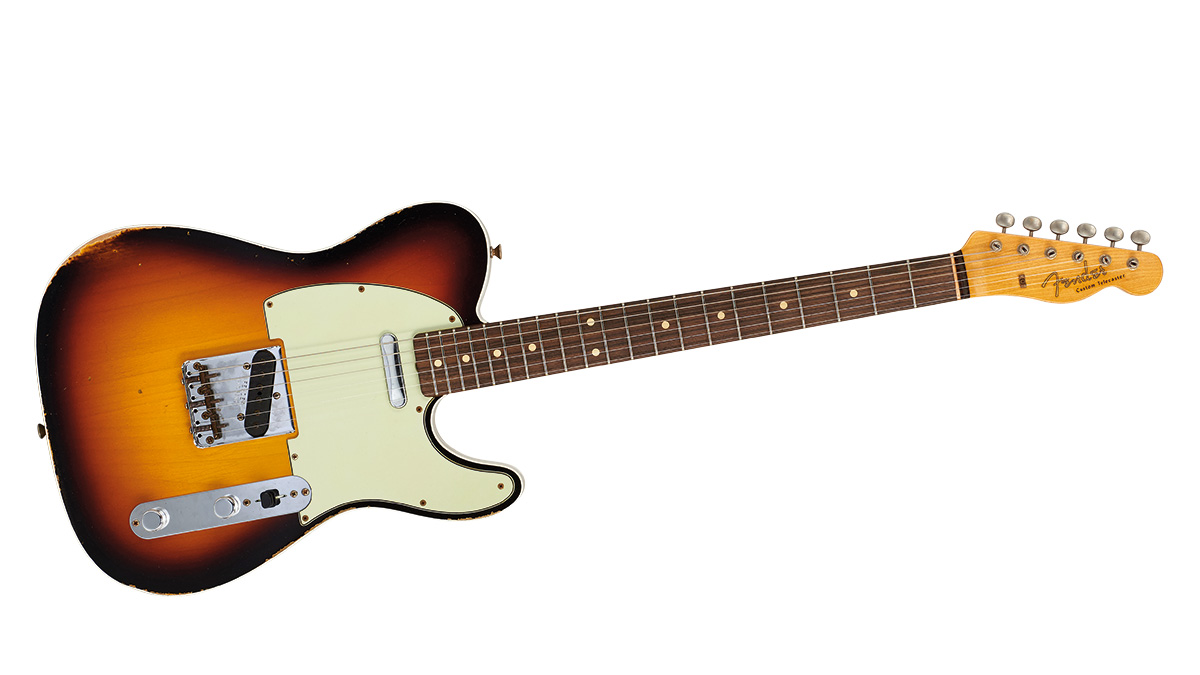MusicRadar Verdict
There's little not to like here - price notwithstanding. And if you're a Tele fan in the market for something a bit special, hand on heart, we couldn't point you in a better direction.
Pros
- +
Fabulous looks: the best Tele version ever; tones; playable neck.
Cons
- -
Mint green 'guard looks slightly artificial; a bit pricey.
MusicRadar's got your back

Fender Relic 1962 Telecaster Custom

Fender Relic 1962 Telecaster Custom

Fender Relic 1962 Telecaster Custom
The artificial ageing of guitars divides opinion between those who get it, and others who think those souls that do are deluded fools.
Well, we love both shiny new, heavily worn and all points in between and - luckily for everyone - Fender does, too.
So, here we have two levels of Relic'ing - there are five in total, from 'hidden under the bed all its life' to 'worked half to death' and all points in between.
Up for review is a lightly aged Tele from the regular 2016 Custom Shop line. Both are built to incredible levels of vintage detail and each is going to set someone's heart racing.
Sonic Blue: it's one of those colours that you either love - or you probably love! It's got that 'ice blue jeans', mega-cool rock 'n' roll 50s vibe written all over it.
That said, a good portion of this Strat's nitro finish has been removed in an effort to evoke 60 years of hard graft, revealing a finely figured lump of ash (well, two actually, although we can't discern any join) lurking beneath. The body has been shaped with the classic deep belly cut and forearm chamfer of early Strats, while the edge radii blend seamlessly into top and back surfaces.
On the mild V-shape neck - the rear playing area of which is all but devoid of finish - the maple is elegantly shaped where it fairs into the headstock, leaving an attractive 'point' as the different surfaces collide.
Artificial wear reveals a player who favoured the top three strings and the fingerboard's lower reaches, venturing to the dusty end for occasional forays, usually in the key of A. Of course, this mythical player is exactly that, but these days, Fender achieves wear and tear with great panache.
In fact, you'd be hard pressed to tell that 1,000 gigs weren't the culprit, and not the talent and abrasive tools of a Fender craftsperson. Hardware is chrome, appropriately dulled and rusted in all the right places.
The 1962 Custom Tele Relic is surely Fender's most attractive adaptation of the Telecaster theme, the addition of off-white double binding lends easy sophistication to this otherwise simple but elegant design.
Coming in at a more acceptable level of wear for many in comparison to the 2016 Relic Strat that we recently reviewed, this instrument seems to have worked all its life, but been cared for by one conscientious owner.
Thus, there are light battle scars - some lacquer checking and a small area of buckle wear on the back. Overall, it's a great-looking package, although we reckon a parchment coloured pickguard would have been a better choice than this rather-too-obvious green one.
Custom Teles emerged in 1959 and so alder is the period correct timber - again, a two-piece spread with no obvious sign of a join - and the three-tone 'burst reveals typical light grain, with maple neck and a deliciously dark slab rosewood 'board.
Post-1967 Tele wiring with master volume and tone controls, plus a three-way selector, complement the standard layout of bridge-mounted rear pickup and chrome-covered neck single coil.
As an aside, it's surprising that Fender hasn't developed a shallower version of its metal Tele jack socket. It would be so easy and would look identical, but would allow the use of the more appropriate right-angled jack, which at present it can't accommodate.
These are different beasts when it comes to playability. The 648mm (25.5-inch) scale and modern 241mm (9.5-inch) fingerboard radius are common to both, but from there, the two diverge somewhat.
With its C-shaped lump of maple pushing slightly towards a D profile, the Tele offers an interesting playing prospect. The extra meat on the shoulders allows over-the-top-thumb players a tad more to pivot against, so string bends become second nature and, again, finger vibrato feels supremely natural.
Sounds
Sound-wise, you get exactly what you expect from this instrument. Contrary to popular belief, Telecaster bridge pickups are darker than those of most Strats, and ours is no exception.
Even wide-open, it doesn't sear the brain, but back off the tone and crank the gain and we're in LP Junior territory. Knock the top-hat selector knob forward a notch and we hit Funky Town: clean, it's everything you could want for Motown and Stax, while piling on a bit of grunt lands you squarely in Stairway... territory.
"Another Strat, another Tele," as Leo Fender famously once pronounced - hence his G&L ASAT's moniker! But when today's Fender Company builds them as convincingly as this, we can only bow in appreciation.
The Tele should street at more like £2,499, in line with many others out there. And as examples of their ilk, these are as good as it gets without shelling out four or five times as much for an original.

“I’ve often wondered if it was the Devil grinning up at me, or God smiling down on me. I still haven’t figured out who had the final say”: How a feat of spontaneous creativity resulted in one of Pink Floyd’s most majestic moments

“It's transparent when not in operation, crisp when looping, and handles high-gain and complex audio sources with ease”: TC Electronic Ditto 2 Looper review

“Instead of pairing a new booster inside this new pedal, think of it as changing lanes inside the pedal”: Mythos and That Pedal Show team up for the Argo Boost Deluxe – an octave fuzz with a switchable boost









